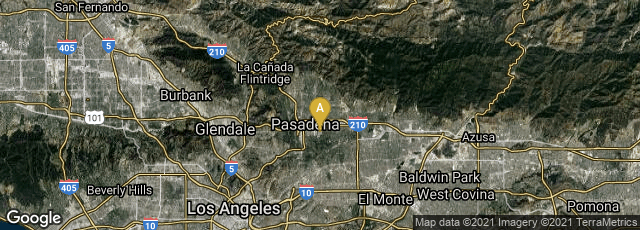

A: Pasadena, California, United States
In 1986 Leroy Hood and Lloyd Smith from the California Institute of Technology developed the first semi-automatic DNA sequencer, working with a laser that recognized fluorescing DNA markers.
"A biologist at the California Institute of Technology and a founder of API [Applied Biosystems, Inc.], Hood improved the existing Sanger method of enzymatic sequencing, which was becoming the laboratory standard. In this method, DNA to be sequenced is cut apart, and a single strand serves as a template for the synthesis of complementary strands. The nucleotides used to build these strands are randomly mixed with a radioactively labeled and modified nucleotide that terminates the synthesis. Fragments of all different lengths result. The resulting array, sent through a separation gel, reveals the order of the bases. Transferred to film, an "autoradiograph" provides a readable sequence from raw data. This data could be transferred to a computer by a human reader.
"In automating the process, Hood modified both the chemistry and the data-gathering processes. In the sequencing reaction itself, he sought to replace the use of radioactive labels, which were unstable, posed a health hazard, and required separate gels for each of the four DNA bases.
" • In place of radioisotopes, Hood developed chemistry that used fluorescent dyes of different colors—one for each of the four DNA bases. This system of "color-coding" eliminated the need to run several reactions in overlapping gels.
"The fluorescent labels were also aspects of the larger system that revolutionized the end stage of the process—the way in which sequence data was gathered. Hood integrated laser and computer technology, eliminating the tedious process of information-gathering by hand.
" • As the fragments of DNA percolated through the gel, a laser beam stimulated the fluorescent labels, causing them to glow. The light they emitted was picked up by a lens and photomultiplier, and transmitted as digital information directly into a computer" (Genome News Network, Genetics and Genomics Timeline 1989, accessed 05-25-2009).
Smith LM, Sanders JZ, Kaiser RJ, Hughes P, Dodd C, Connell CR, Heiner C, Kent SB, Hood LE (12 June 1986). "Fluorescence Detection in Automated DNA Sequence Analysis". Nature. 321 (6071): 674–79. Bibcode:1986Natur.321..674S. doi:10.1038/321674a0. PMID 3713851. .